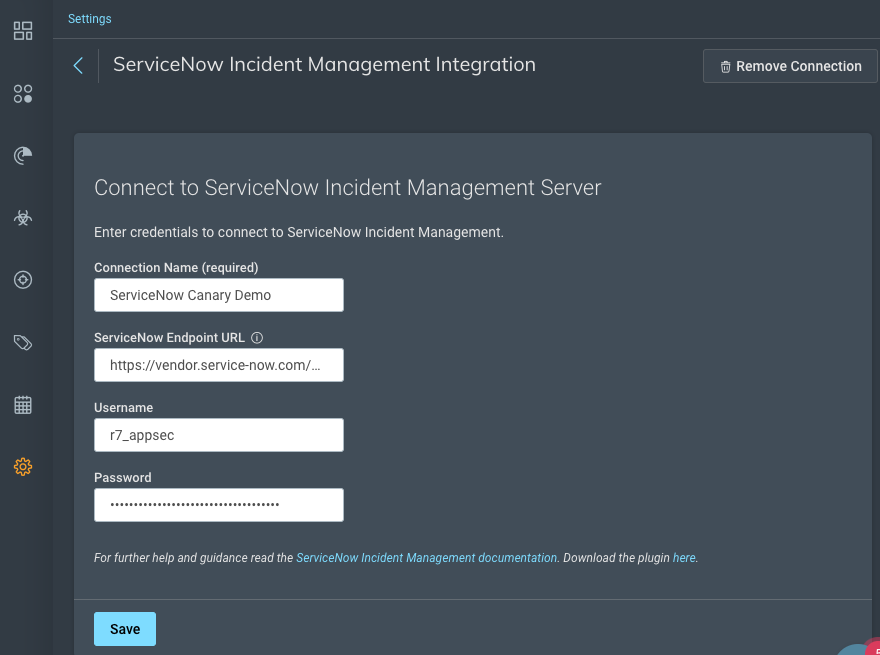Manage Vulnerabilities with ServiceNow ITSM
If you utilize ServiceNow for managing incidents across your organization, you can simplify your ticketing management and validate vulnerabilities faster by integrating with InsightAppSec. You can easily export your vulnerabilities to ServiceNow so that vulnerability status and severity changes are automatically updated in both applications.
Two-way integration
The connection between ServiceNow and InsightAppSec is two-way integration. When an incident is updated in ServiceNow, the vulnerability status and severity in InsightAppSec is also updated.
Integrate with ServiceNow
Integrate InsightAppSec and ServiceNow in just a few steps. Download the InsightAppSec app from the ServiceNow app store and configure it within ServiceNow. After configuration, add the ServiceNow connection to InsightAppSec so that you can start exporting your vulnerabilities.
Before you begin
- Ensure you have an organization-level InsightAppSec API key to use for ServiceNow configuration. If not, create a new key.
Download the InsightAppSec ITSM app from ServiceNow
InsightAppSec for ITSM is available in the ServiceNow Store which enables quick and easy integration at no additional cost. You must have a license for both products.
Required credentials
A Rapid7 InsightAppSec connection configuration can be created by those with the x_r7_rapid7_inc.configuration_admin role or by any platform administrator.
Get the app
Download the app and create a connection configuration
- In the ServiceNow app store, search for Rapid7 InsightAppSec for ITSM.
- Download the app and create a Rapid7 InsightAppSec connection configuration by following these instructions:
- Use the Filter Navigator to access the Rapid7 InsightAppSec for ITSM application menu.
- In the Configuration module, click New and enter the required information. Optional fields can be populated or left empty depending on preference.
- Name - for the configuration
- Region Code - the Rapid7 data region
- API Key - a Rapid7 InsightAppSec API Key
- Click Submit to save the configuration.
Create a dedicated integration user
After the connection configuration is created, you must create a dedicated integration user. To do so,
- Navigate to the User Administration > Users menu.
- Click New and complete the User details.
- Choose a password that conforms to the ServiceNow password policy.
- Check the Web service access only checkbox.
- Submit the changes to create the user.
- Navigate to the created user and select the user record for editing.
- In the Roles section select edit to add a new role.
- Add the x_r7_rapid7_inc.appsec_api_user role, click Save, then click Update.
This dedicated integration user will be configured inside Rapid7 InsightAppSec when defining the ServiceNow connection.
Modify default mapping
To modify the default field mappings between InsightAppSec and ServiceNow,
Mapping modifications
Modifying default field mappings is optional and can only be done by a system administrator.
- Go to System Import Sets > Administration > Transform Maps.
- Search for InsightAppSec.
- In the Table Transform map, select InsightAppSec Vulnerabilities.
- Modify the defined Field Maps.
Connect InsightAppSec to ServiceNow
After configuring the connection in ServiceNow, add the ServiceNow connection details to InsightAppSec.
Add the ServiceNow connection
- In InsightAppSec, go to Settings > Integrations, and click Enable ServiceNow Integration.
- Enter the connection details.
- To ensure the credentials work, click Test Connection.
- If the test connection fails, check the ServiceNow Endpoint URL and your credentials and try again.
- Click Save.
What is the ServiceNow Endpoint URL?
The ServiceNow endpoint is the URL and the API endpoint. For example:
https://vendor.service-now.com/api/x_r7_rapid7_inc/v1/ias
Manage the connection
- Go to Settings > Integrations and click Manage ServiceNow.
- To edit the connection, update the connection details and click Save.
- To delete the connection, click Remove Connection and click Confirm.
Export vulnerabilities to ServiceNow
You can export vulnerability data in multiple formats for use in other applications.
- On the Vulnerabilities page or tab, select the vulnerabilities you want to export.
- Click Export Vulnerabilities and select ServiceNow.
Vulnerabilities are sent to your ticketing application.
What happens if I export a vulnerability that has already been exported?
The existing ticket in ServiceNow will be updated. A duplicate ticket for the same vulnerability will not be created.
Automatic updates to vulnerability status and severity
After a vulnerability is exported to ServiceNow, any changes to the status from either application are automatically updated in both places. In InsightAppSec, these updates are tracked in the Change History field. Instead of a username associated with the change, changes made from ServiceNow display the change as made by API User.
InsightAppSec and ServiceNow have different statuses and severities that are mapped to reflect the default statuses of each application.
Status mapping
ServiceNow allows you to customize incident statuses. This section describes the default mapping that is included in the configuration.
Updates to vulnerability status in InsightAppSec map to the following ServiceNow incident statuses.
| InsightAppSec vulnerability status | ServiceNow incident status |
|---|---|
| Unreviewed | 1 (New) |
| False Positive | 1 (New) |
| Verified | 1 (New) |
| Ignored | 1 (New) |
| Remediated | 1 (New) |
| Duplicate | 1 (New) |
Updates to incidents in ServiceNow map to the following InsightAppSec statuses.
| ServiceNow incident status | InsightAppSec vulnerability status |
|---|---|
| 1 (New) | N/A |
| 2 (In Progress) | N/A |
| 3 (On Hold) | N/A |
| 6 (Resolved) | Remediated |
| 7 (Closed) | Remediated |
| 8 (Canceled) | N/A |
Severity mapping
| InsightAppSec severity level | ServiceNow severity score |
|---|---|
| Safe | 3 |
| Informational | 3 |
| Low | 3 |
| Medium | 2 |
| High | 1 |

